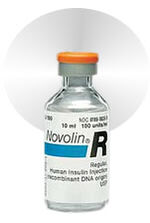No edit summary |
m (Unprotected "Bolus": Bot: Unprotecting page) |
||
| (15 intermediate revisions by one other user not shown) | |||
| Line 1: | Line 1: | ||
| + | [[Image:Novolin_R.jpg|150px|thumb|left|Novolin, a [[:Category:Short-acting|fast-acting]] insulin suitable for use as a bolus insulin.]] |
||
| ⚫ | |||
| + | |||
| ⚫ | This refers to the fast- or rapid-acting insulin diabetics use at mealtimes. Doing a curve on anyone will indicate how blood glucose levels rise after eating. This is called a [[post-prandial]] or post-meal spike; in humans, it commonly begins about 2 hours after food. The pancreas of a non-diabetic simply produces more insulin to handle the additional glucose. |
||
But diabetics cannot and so some take an additional [[:Category:fast-acting|fast-acting]] or [[:Category:short-acting|short-acting]] bolus insulin to manage the spike. |
But diabetics cannot and so some take an additional [[:Category:fast-acting|fast-acting]] or [[:Category:short-acting|short-acting]] bolus insulin to manage the spike. |
||
| − | Bolus insulin can also be referred to as "mealtime" or "prandial" insulin because it is meant to handle the glucose increase from food<ref> |
+ | Bolus insulin can also be referred to as "mealtime" or "prandial" insulin because it is meant to handle the glucose increase from food. <ref>{{cite web|url=http://www.aafp.org/afp/2004/0801/p511.html?printable=afp|title=Your Insulin Therapy|year=2004|publisher= American Family Physician}}</ref> Bolus differs from [[corrective insulin]] because it is part of the daily insulin routine--given slightly before or just after meals, depending on the insulin used. |
| − | Caregivers with pets that have strong post-prandial or post-meal spikes often manage those spikes better by using a [[Lente]] insulin instead of an insulin like [[NPH]]<ref> |
+ | Caregivers with pets that have strong post-prandial or post-meal spikes often manage those spikes better by using a [[Lente]] insulin instead of an insulin like [[NPH]], <ref>{{cite web|url=http://www.vin.com/VINDBPub/SearchPB/Proceedings/PR05000/PR00105.htm |title=Diabetes Mellitus-Treatment Options-Lente Insulin & Post-Prandial Spikes|author=Bruyette, David|year=2001|publisher=WSAVA}}</ref> being 30% [[semilente]] (a short-acting insulin) and 70% [[ultralente]] (a [[:Category:long-acting|long-acting]] insulin), handles the spike with its short-acting semilente portion. |
Some caregivers also manage post-meal spikes through changes in the pet's dietary regimen, for example by feeding several small meals during the day rather that a few large meals. |
Some caregivers also manage post-meal spikes through changes in the pet's dietary regimen, for example by feeding several small meals during the day rather that a few large meals. |
||
| Line 12: | Line 14: | ||
For other uses of an extra, [[:Category:short-acting|short-acting]] insulin in addition to use as a bolus, see [[corrective insulin]]. [[Image:I16.gif]] |
For other uses of an extra, [[:Category:short-acting|short-acting]] insulin in addition to use as a bolus, see [[corrective insulin]]. [[Image:I16.gif]] |
||
| + | |||
| ⚫ | |||
| + | {{Reflist|colwidth=30em}} |
||
==More Information== |
==More Information== |
||
| − | *[http://www.vin.com/VINDBPub/SearchPB/Proceedings/PR05000/PR00157.htm Use of fast-acting insulin when intermediate-acting insulins are not enough |
+ | *[http://www.vin.com/VINDBPub/SearchPB/Proceedings/PR05000/PR00157.htm Treating the Complicated Diabetes Patient] David B.Church, 2001, WSAVA<br>Use of fast-acting insulin when intermediate-acting insulins are not enough. |
| − | |||
| ⚫ | |||
| − | <references/> |
||
[[Category:Insulins]] |
[[Category:Insulins]] |
||
[[Category:Regulation]] |
[[Category:Regulation]] |
||
Latest revision as of 23:26, 23 May 2012

Novolin, a fast-acting insulin suitable for use as a bolus insulin.
This refers to the fast- or rapid-acting insulin diabetics use at mealtimes. Doing a curve on anyone will indicate how blood glucose levels rise after eating. This is called a post-prandial or post-meal spike; in humans, it commonly begins about 2 hours after food. The pancreas of a non-diabetic simply produces more insulin to handle the additional glucose.
But diabetics cannot and so some take an additional fast-acting or short-acting bolus insulin to manage the spike.
Bolus insulin can also be referred to as "mealtime" or "prandial" insulin because it is meant to handle the glucose increase from food. [1] Bolus differs from corrective insulin because it is part of the daily insulin routine--given slightly before or just after meals, depending on the insulin used.
Caregivers with pets that have strong post-prandial or post-meal spikes often manage those spikes better by using a Lente insulin instead of an insulin like NPH, [2] being 30% semilente (a short-acting insulin) and 70% ultralente (a long-acting insulin), handles the spike with its short-acting semilente portion.
Some caregivers also manage post-meal spikes through changes in the pet's dietary regimen, for example by feeding several small meals during the day rather that a few large meals.
With dogs, opinions differ. Some caregivers use the methods above with success, others believe that a basal/bolus regime is safer and more effective for their dogs. Since dogs are more prone to cataracts and certain other complications of hyperglycemia, and in general have higher post-prandial spikes, it may be important to regulate them more tightly than cats.
For other uses of an extra, short-acting insulin in addition to use as a bolus, see corrective insulin. ![]()
References[]
- ↑ Your Insulin Therapy. American Family Physician (2004).
- ↑ Bruyette, David (2001). Diabetes Mellitus-Treatment Options-Lente Insulin & Post-Prandial Spikes. WSAVA.
More Information[]
- Treating the Complicated Diabetes Patient David B.Church, 2001, WSAVA
Use of fast-acting insulin when intermediate-acting insulins are not enough.